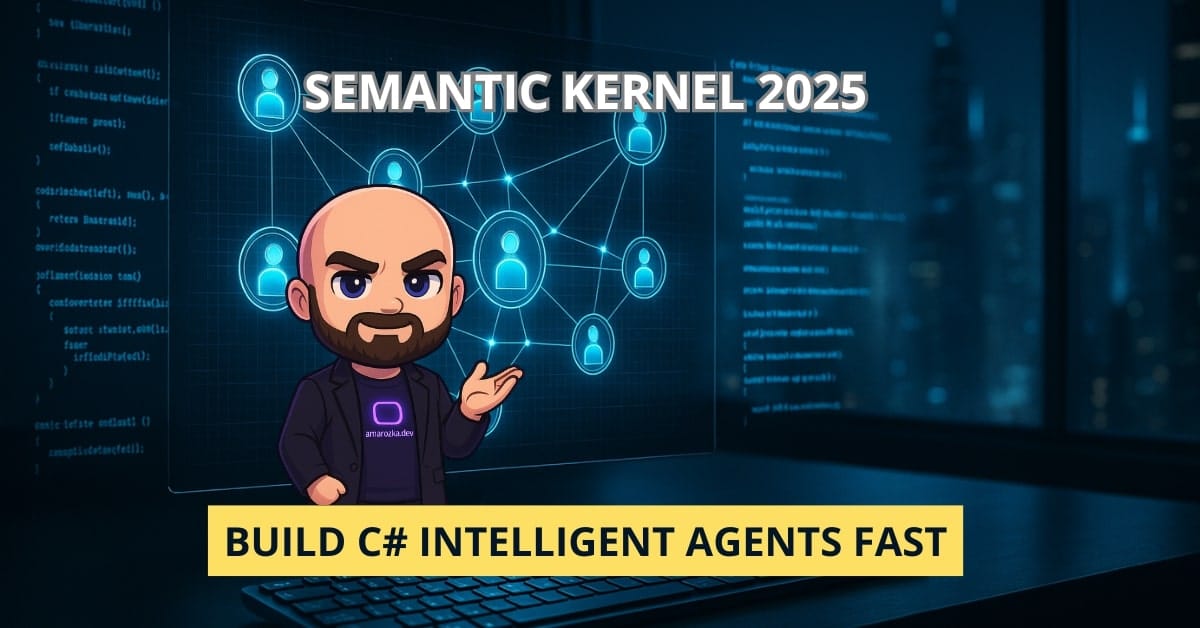Are you still wiring scattered prompts together and calling it “AI integration”? Let me show you why 2025 is the year we graduate from plain prompt‑based skills to full‑fledged intelligent agents – and how the brand‑new IAgent interface in Microsoft’s Semantic Kernel makes that leap painless.
Agents vs. Plain Skills – Why You Should Care
Remember the first time you swapped out raw SQL for Entity Framework and suddenly everything clicked? That’s the jump we’re about to make for AI workflows.
- Plain skill – Single, stateless function you invoke and promptly forget.
- Agent – Autonomous problem‑solver that reasons, plans, and adapts – so you can delegate outcomes, not just calls.
Enter the new IAgent contract in Semantic Kernel 1.5 – a lightweight, opinionated API for building, hosting, and chaining agents.
Agent Anatomy: Dissecting the Beast
Every agent in Semantic Kernel 1.5 follows the same internal blueprint:
| Building Block | Purpose | Typical Implementation |
|---|---|---|
| Goal | High‑level objective expressed in natural language (e.g., “Schedule a status summary email before 5 PM”). | AgentGoal record or prompt template |
| Planning Loop | Iterative chain-of-thought that breaks a goal into executable steps. | Built‑in Tree of Thoughts planner or custom heuristic planner |
| Scratch‑Pad | Streaming memory buffer storing observations, tool outputs, and interim thoughts. | KernelMemory or vector store plug‑in |
| Tool Invocation | Bridge between internal thoughts and external capabilities (APIs, skills, functions). | SK Plugin methods decorated with [KernelFunction] |
| Self‑Reflection | Meta‑reasoning about past actions to avoid loops or hallucinations. | Reflection prompt + JSON rubric |
Tip: The scratch‑pad isn’t just for the model; it’s your debug log. Pipe it into Application Insights and you’ll thank yourself when latency spikes at 2 A.M.
Code Skeleton
public interface IAgent
{
Task<AgentResult> RunAsync(AgentGoal goal, CancellationToken ct = default);
/// <summary>
/// Inject additional tools or skills at runtime.
/// </summary>
void AddPlugin<TPlugin>(TPlugin plugin) where TPlugin : class;
/// <summary>
/// Hook custom telemetry or guardrails.
/// </summary>
event EventHandler<AgentStepEventArgs> StepCompleted;
}Implementing a Single‑Agent Task Solver
Let’s build a Release Notes Generator – an agent that:
- Scans merged PRs on GitHub.
- Groups them by feature area.
- Produces release notes with markdown formatting.
Define the Goal
var goal = new AgentGoal("Generate concise, user‑facing release notes for version 3.2. Group by feature area and link each PR.");Register Tools (Plugins)
var gitHub = new GitHubPlugin(env["GITHUB_TOKEN"]);
var markdown = new MarkdownPlugin();Wire Up the Agent
IAgent agent = new KernelAgentBuilder()
.WithOpenAI("gpt-4o-mini")
.AddPlugin(gitHub)
.AddPlugin(markdown)
.WithReflection()
.Build();
var result = await agent.RunAsync(goal);
Console.WriteLine(result.Value);Observe the Planning Loop
Use the built‑in step event to watch the agent think:
agent.StepCompleted += (_, e) =>
Console.WriteLine($"[{e.StepNo}]→ {e.Thought}");Sample output:
[1]→ Fetch merged PRs since tag v3.1
[2]→ Cluster PRs by DIRECTORY structure
[3]→ Summarize cluster 'Authentication'
[4]→ Render markdown listThat’s it – no extra glue code, retries, or pagination logic. The planner decides when to invoke gitHub.ListMergedPrsAsync or markdown.RenderAsync.
Advanced Features That Make Agents Really Smart
Self‑Reflection
After each step, the agent evaluates its own output:
{
"score": 0.83,
"actionRequired": false,
"rationale": "Information complete and formatted correctly."
}Bad score? The planner revises its approach automatically.
Dynamic Replanning
Unforeseen obstacle (e.g., GitHub API rate‑limit)? The agent injects a new step – WaitUntilQuotaResets() – without throwing.
Guardrails
Attach a policy to redact PII:
agent.AddGuardrail(new RedactPolicy("[A-Za-z0-9._%+-]+@[A-Za-z0-9.-]+\.[A-Za-z]{2,}"));If sensitive data sneaks into the scratch‑pad, the guardrail intercepts the step and scrubs it.
Analogy: Think of guardrails as the compiler warnings of agent land – fail fast, fail loud.
FAQ: Everything You Were Afraid to Ask
Copilot Chat is a hosted chat experience optimized for real‑time Q&A inside tooling. An agent is library code you own, can run headless, schedule, or embed in pipelines. Copilot may use agents under the hood, but with Semantic Kernel you build them directly.
Absolutely. Because an IAgent is just a POCO, you can wrap it in gRPC, REST, or Azure Container Apps. I deploy mine as serverless functions; build triggers fire, agent writes release notes back to GitHub.
Conclusion: From Lone Wolves to Symphonic Swarms
You’ve built a single agent that can read code, think, and publish docs – pretty slick. But the real magic unfolds when multiple agents collaborate: a Planner Agent decomposes portfolio goals, a Research Agent enriches context, a Validator Agent enforces compliance. We’ll orchestrate that symphony in the next post.
Ready to unleash your own cohort of code whisperers? Try upgrading one of your dull prompt chains to IAgent today and share the outcome in the comments!
